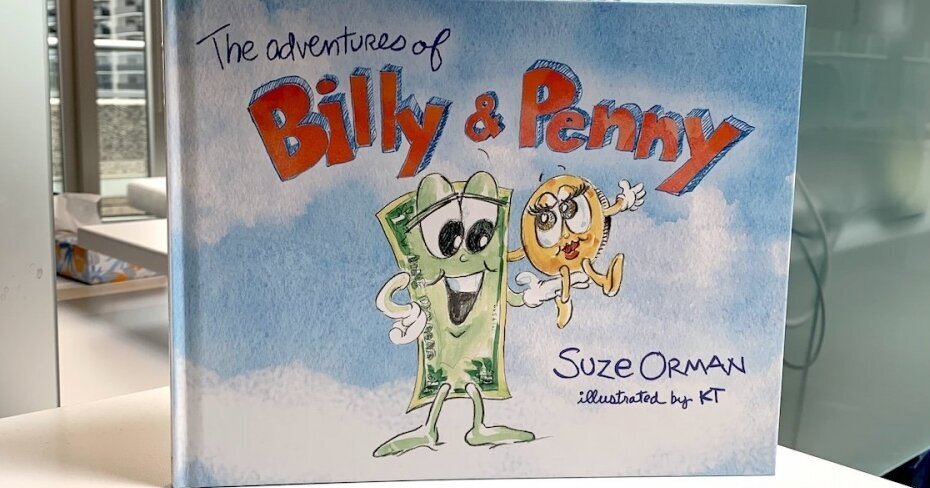Can Suze Orman’s children’s book make kids care about personal finance?
By: Lisa Coxon on April 10, 2019
It’s Saturday night at 8 o’clock, and I’m on bedtime story duty. Nestled among some Lightning McQueen bed sheets and pillows, I’m about to read my nephew something a little different from his usual literary fare: American financial expert Suze Orman’s debut children’s book, The Adventures of Billy and Penny. With Orman’s help, I’m going to attempt to teach a four-year-old about money.
Illustrated by Orman’s wife, Kathy Travis, The Adventures of Billy and Penny is the story of a one-dollar bill named — wait for it — Billy, and a penny named, well, you get it. Billy and Penny live in the same house but aren’t treated with equal care. Penny can sense that the family just doesn’t see the value in her anymore. They see her on the floor or in the car console but don’t bother to pick her up. But Billy is determined to make the family realize that pennies matter just as much as bills do.
Every Thursday night, the family orders pizza. So Billy — creative guy that he is — decides to tell all the other bills inside the mom’s wallet to go and hide. When she goes to grab her wallet so she can pay the delivery guy, she realizes she has no money. She has to enlist the help of her kids to quickly collect all the unwanted and forgotten pennies that have been left lying around — in the washing machine, in the kids’ piggy banks, in the car console, on the floor — and see if they can come up with enough to pay the pizza delivery man $10.
Before I read the book to my nephew, I passed it around to a few adults — and in some instances, provided a brief oral Coles Notes version — to gauge their reactions. None were all that impressed. The plot fell flat, they said.
But that’s not the target market, so I’m going to let my nephew decide. Wisely, he suggests we start at the “berry beginning.”
The book opens with Billy waking himself from a deep slumber, comfortably wedged inside the mother’s wallet. He jumps to the ground and trips over his friend, Penny. Penny, what are you doing on the floor? The floor is no place for money, he says.
An American book may not be able to dispense the most relevant financial lessons, considering we live in a country where $1 bills don’t exist and pennies went out of circulation before he was born
“Penny is that one,” my nephew says, pointing to the illustrated coin with long curly eyelashes and bright red lipstick.
“Yep, and Billy is this dollar-bill,” I tell him, realizing only in this moment that an American book may not be able to dispense the most relevant financial lessons, considering we live in a country where $1 bills don’t exist and pennies went out of circulation before he was born. Solid pick, Aunt Lisa.
But then I remember something. Not long ago, my nephew was helping his dad shovel snow out of the neighbour’s laneway. To thank him for his hard work, the neighbour gave my nephew $10. Once he came back inside the house, my nephew excitedly told his mom: “Marty just gave me a 10-pack of dollars!”
So, I tell him that even though Billy looks a little different, he’s just like that 10-pack of dollars. That seems to click.
Four years old might be too young to understand the concept of saving, but that’s what Orman tries to teach young readers in this 36-page book. Suitable for those aged three to seven, The Adventures of Billy and Penny aims to teach kids a couple of lessons: that all money is valuable, and that saving it, no matter how small the quantity, is always helpful. Orman also strives to teach kids basic equivalencies (like how many pennies equals how many dollars), and she even manages to squeeze in a couple decent puns throughout — like when the mother hands the pizza delivery guy two bags full of pennies and tells him to “Keep the change.” It’s entirely lost on my nephew, but gives me a good chuckle.
About halfway through the book, I test my nephew to see how much of these lessons he’s absorbing. “How much do you think 1,000 pennies are worth?” I ask, knowing that Orman has already given him the answer.
“100?” he says. Not too shabby for a four-year-old who knows very little math. He’s thinking about earlier on in the book when Billy tells Penny that 100 pennies equals what he is: a one-dollar bill.
“Close,” I tell him. “1,000 pennies is actually worth $10,” I say.
Before it’s lights out, my nephew suckers me into reading him three more books. Admittedly, he seems more excited by reading about excavators than money
As we approach the end of the book, we see Penny finally get her moment of fame. Realizing her value, one of the children picks Penny up off the floor, dusts her off, and puts her inside a jar labelled “Pizza pennies.” The kids agree to save every penny they find until they have enough to buy pizza for dinner again. (I feel pretty bad for that delivery guy.)
Before it’s lights out, my nephew suckers me into reading him three more books. Admittedly, he seems more excited by reading about excavators than money. But as we lay there, me waiting for him to fall asleep, him chattering away and flinging his feet in my face, I nudge him some more about the book. Did he enjoy the story, I wonder? Did he even remember it?
“So, what did you think of Billy and Penny?” I ask.
“Um, Billy got caught,” he says. “No — Penny. Penny got caught into a jar.”
“And what’s the name of that jar?” I ask him.
“Piggy jar,” he says.
“Piggy bank,” I say, correcting him while holding in a laugh. “It’s where you keep all your money.”
“I have a bigger one and I got so much coins!” he boasts. “I even got a coin from the stairs. Dad dropped it.”
The book has good intentions but it might not be so effective for its target age bracket — at least the lower end of that range
“And you saved it?” I ask. Maybe I was wrong about the concept of saving going over his head.
“Yeah, I got more than him,” he says proudly.
“You have more money than your dad?” I ask.
“No, I got more pennies than him.”
“Do you have any Billys?” I ask.
“No.”
“What about your $10 bill?” I ask.
“Yeah, that’s Billy,” he says, giggling.
“And how did you get that?”
He recounts cleaning the neighbour’s laneway. “I just cleaned it so much,” he tells me. “I’m not even joking… he actually gave me Billy. I just call them those names because their names are Billy and Penny. I will remember them for the whole entire day. Billy. Penny.”
Orman’s first foray into the world of children’s books isn’t without merit. The book has good intentions but it might not be so effective for its target age bracket — at least the lower end of that range. It felt a little advanced for my nephew, who seemed to be more confused by the book than excited by it.
As he tries to fall asleep, my nephew continues to ramble on, making less and less sense with every sentence, and drawing some unintended conclusions from the book.
“No, no, no, this is not good,” he says. “Remember Billy was the only one free?”
“The only one free?” I ask.
“Like the only one that could walk,” he says, aptly referring to the fact that Billy was the only bill illustrated with arms and legs.
“And Penny. She was trapped in the jar,” he continues. “And remember the bill guy... what’s his name again?”
“Billy,” I say.


